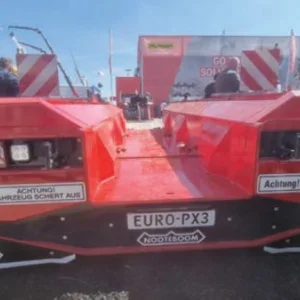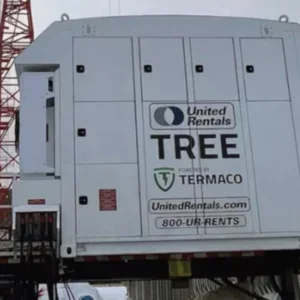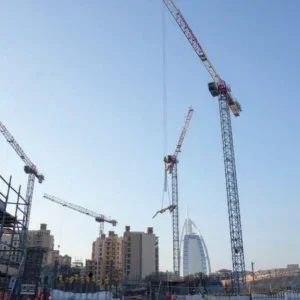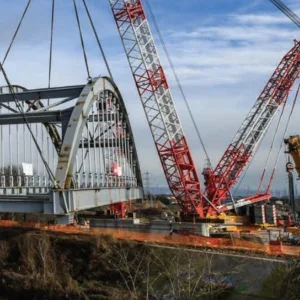With 25 years spent in the crane industry, I still have never experienced a crane accident where the machine or its safety systems were at fault. All the accidents I have experienced have been related to one of the following three topics:
1. Improper set up of the crane
2. Deliberate disabling part of or the entire crane safety system
3. Improper rigging practice or insufficient/incorrect rigging equipment.
Further, I believe, that more than 80% of all mobile crane jobs are routine assignments, where the crane operator has performed similar jobs over and over again. Nine out of ten accidents involving mobile cranes occur in connection with routine assignments and the crane industry rarely experiences accidents with mobile cranes on “non-routine jobs”, because the operator is “on alert” and because a lot of planning normally has been put into the assignment prior to its execution.
My presentation only relates to routine assignments and the presentation is based solely on my own 25 years of experience within the mobile crane industry.
My experience with mobile cranes comes from:
– 11 years as managing director of BMS and as such head of safety
– 9 years as head of operations – vice president in United States for a major European crane manufacturer
– 6 years as crane sales manager
The problem with a presentation like this is that it is based on my personal assumptions and observations and not on official data or statistics. The reason for this is that too many countries including my own have no history of

collection data and producing statistics relating to accidents with mobile cranes, at least not statistics nor data like what we saw from Japan at last year’s Crane Safety Seminar and this is a pity because both the public and the mobile industry jointly have an interest in such data. We, that is the mobile crane industry and our interest organisations like ESTA, SC&RA and similar national associations and organisations, should all encourage crane owners to press forward and make such data available.
With such data and statistics we can learn from each other, thus avoiding to repeat a mistake already made by another crane owner. A mistake becomes a stupidity once you repeat it. The mistakes in the mobile crane industry or our accidents more often than not results in the destruction of expensive equipment, expensive property and unfortunately also in death.
One problem in relation to the production of valid and reliable data or statistics are that crane operators and owners involved in accidents often have no interest in making such data available. It could potentially hurt customer relations or company reputation.
Again it is a pity that accurate and reliable information is not available. Owners of mobile cranes need this information. It would enable all of us to better plan our safety work and train our operators. Accurate and reliable information could potentially also bring us significant insurance savings.
When crane accidents happen, you very often read about them in the newspapers, watch them on the news in the television because these accidents are spectacular through the eyes of the press. At Easter 1999 we had a big accident with one of our cranes falling into a lake because it had been set up at a place with unsafe ground conditions. Our rescue operation – the most difficult we have ever made – was done under full TV coverage and a nearby school sent two busloads of kids to follow the dramatic recovery of our crane. Stories like that sell newspapers, it gives spectacular pictures and it makes the public believe that our cranes are dangerous machines and that our industry is a dangerous place to work in. We do not need that reputation.
When you think back at crane accidents reported in the press, in most cases the press will report that investigators are looking into and examining the crane. At least in the beginning it is always the crane that takes all the blame for the accident.
In order to try to prevent crane accidents from happening it is necessary to analyse and understand why these accidents happen. Once you understand the causes, maybe what we should call the “behind the scene causes”, you can develop the safety work in your company for cranes and crane operators alike.
Based on my own 25 years of experience in the crane industry I have yet to see a crane fail or tip-over for any reason other than human error when properly operated, maintained and serviced according to the manufacturers written instructions, the length of which by the way, has gone out of control.
As mentioned at the beginning of this presentation, more than 90% of all crane accidents take place during routine work and not during large and complicated jobs, where a lot of resources have been employed in planning and performing the work. I want to stress that these are my own personal observations based on my own experiences from the crane industry.
As mentioned before most crane accidents will fall into one of the following three categories:
1. Accidents where the crane is tipping over due to insufficient or unsafe ground conditions.
2. Disabling part of or the entire crane safety system
3. Improper rigging practice or insufficient/incorrect rigging equipment
Unsafe ground conditions
The only way to deal with insufficient/unsafe ground bearing capabilities is to always and without fail to employ additional supporting plates under the crane’s outriggers. These plates can be steel-, aluminium- or fibre plates.
No crane should ever, and I stress, should ever be set up on any surface, whatsoever, without using these additional supporting plates. It makes no difference whether it is a concrete surface, a paved road, firm consolidated soil, anything. Additional supporting plates in various sizes should always be used.
One must always inquire into and investigate the ground bearing capabilities at the site where the crane is to be erected and work. This is necessary in order to determine the size and other features of additional supporting plates to be used. Remember always to pay particular attention to the possible presence of underground piping, tunnels, cellars, sewer systems, and the like.
Also remember that these investigations into the ground bearing capabilities at the site, is the sole responsibility of the crane owner, not the customer. He or she might be able to give you various data regarding the underground, but we are the experts and we have to take responsibility also here.
We at BMS have, for internal use and strictly based on ground conditions found in Denmark, developed a table which engineers and crane operators can use when in doubt.
We have had more than our fair share of cranes that tipped over, due to insufficient or unsafe ground conditions. This is the reason why we as a standard procedure always, and without fail, without any excuse whatsoever, always employ additional plates under our outriggers. I believe that insufficient or unsafe ground conditions are the reason behind nine out of ten accidents where a crane is tipping over. This is probably the same ratio as for accidents with outrigger supported access platforms.
I dare say, and please knock on wood, that we have put this problem behind us, we probably have among the lowest accident rate today in our industry and customer surveys indicates that customers always consider us their safe choice, not necessarily the cheapest, but the safest.
I have also seen a large number of truck mounted loader cranes tipping over due to insufficient or unsafe ground conditions. It is not only mobile cranes.
It is bad enough to witness all these accidents where cranes, property, buildings and the like are damaged or destroyed. It is nothing less than a disaster to experience an accident involving a truck mounted platform tipped over due to insufficient or unsafe ground conditions. The loads in these machines are human beings and no claim for damage can replace a human being.
Let me conclude on this part of my presentation:
Do always, whatever you work without fail, use additional plates under the outriggers of any loader crane, mobile crane or truck mounted platform.
Disabling of crane safety systems
Disabling any part of the entire crane safety systems other than during erection or disassembly of the crane should never be done. Tampering with a cranes’ safety system happens when:
– The crane assigned for the job is too small from the beginning!
– The actual load is heavier than the original information indicated by customer.
– The operator does not, for any number of reasons, move the crane close enough to the load.
Crane owners must have policies and procedures in place supporting their operators should they encounter a situation where they can not complete a job without disabling part of or all of the crane’s safety system. In most cases the only proper solution is to stop the work and employ a bigger crane. This is also true in the situations where the crane owner has to cover the additional costs associated with the exchange of the crane.
Crane owners must sanction not only operators who disable part of or the entire crane safety system but also operator supervisors who accept, allow or even worse who instruct crane operators to tamper with a crane’s safety systems.
As the crane owner you should never underestimate the pressure crane operators meet from customers when the operator refuses to disable part of or the entire crane safety system. Comments like: “The guy we had last time did it so why can’t you do it?”
“You’re a chicken, your colleagues do it all the time.”
These customers put their own money and time ahead of our safety and once we have the accident they will never back you. The problems and costs are all yours including not to forget all ramifications, so crane operators or owners make a grave misunderstanding when he or she believes that they are helping a customer by disabling the crane’s safety system. If any accident happens the customer will sue you anyway for loss or damage of property, lost production and the like.
In some situations it is possible to disable part of the crane’s safety system without endangering crane safety, but this is a decision, that either the crane manufacturer should make, or a decision to be made by the management of the crane company after careful consultations and considerations, and as mentioned involving the management of the crane company and/or the crane manufacturer. It is never, and I repeat, it is never a decision our crane operators must or should be left alone to make.
Too often we experience customers who for any number of reasons are not telling the crane owner the correct weight of the load. This leads to the situations where the crane delivered to the job fully erected is too small from the beginning. “Who is paying now?” Again don’t disable the crane’s safety system in order to help the customer. Once you start doing so, the full responsibility passes on from the customer to the crane operator and the owner, and suddenly you have taken full responsibility for an error made by a customer.
As mentioned there can be any number of reasons why the customers are not telling you the correct weight. In many cases the reason is that customers only have an estimate, they do not know the exact weight of the load. Demolition jobs are, if not outright hated then at least feared by many crane owners and operators, because it is very difficult to calculate the correct weight of the load.
I have seen too many accidents with cranes tipping over in these job situations. We have learned bitter lessons in our company with these jobs and today we always add 25% safety margin to the load, and we employ the cranes accordingly.
We also put a lot of effort into verifying the load indications given by our customers by examining either drawings, the load to be lifted, etc. On demolition jobs we always employ either a very experienced branch manager, our company safety manager or project manager in connection with our local sales representative. These people jointly have to evaluate how to execute the assignment and they jointly have the responsibility for load calculations.
In conclusion I claim, based on my past experience that crane safety systems in use today are adequate to protect proper crane function. We do not need new or different safety systems, we just need to make sure that we are not disabling the ones we already have.
Improper rigging
I, myself, am not aware of any other country that considers slingers to be very important, or at least considers them to be important enough to be awarded their own certificate. This is a major mistake. Proper rigging education, proper rigging practise, proper rigging certification is as important as proper use of the crane and its safety systems. Improper rigging is as dangerous as improper use of the crane.
No crane should ever be employed and operated without the assistance of a certified rigger. On many sites customers provide the rigger and no crane owner should ever accept uncertified riggers provided by their customers to perform this critical work.
Crane owners must press for legislation or industry regulation in their respective countries requiring the use of certified riggers in all crane operations.
The problem of having uncertified riggers also relates to the lack of reliable crane accident statistics. Once we have these statistics, I am sure that our regulatory bodies would see the need for this critical certification. I am pleased to say that mandatory certification of riggers now is a subject discussed with industry regulators in my country and of course it is my hope for the Danish mobile crane industry that these discussions within a shore time will result in mandatory certification.
For me it is time to conclude:
I believe that the safety systems already in place in our equipment in general are adequate to protect proper crane function. We – the crane owners – need to make sure that our operators and crane supervisors are well educated, trained and last but not least have the right attitude when it comes to safety. With education, training and attitude in place we won’t see:
– Accidents where the crane is tipping due to insufficient or unsafe ground conditions.
– Where operators are disabling part of or the entire crane system
– Improper rigging practise or insufficient/incorrect rigging equipment
When we have achieved that, we can greatly reduce the time we spend on safety issues, needless accidents, potential injuries and high insurance costs.
Thank you.






